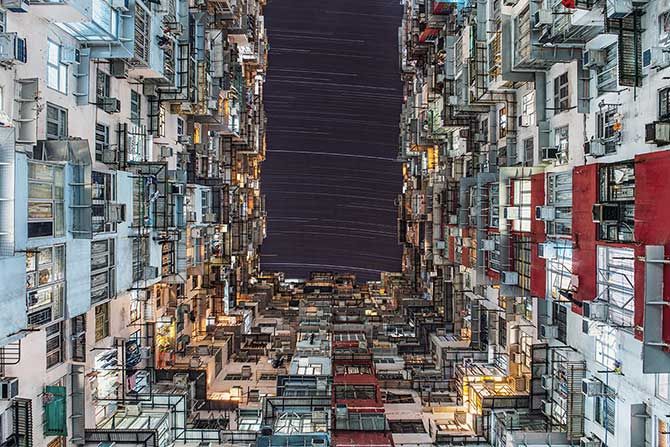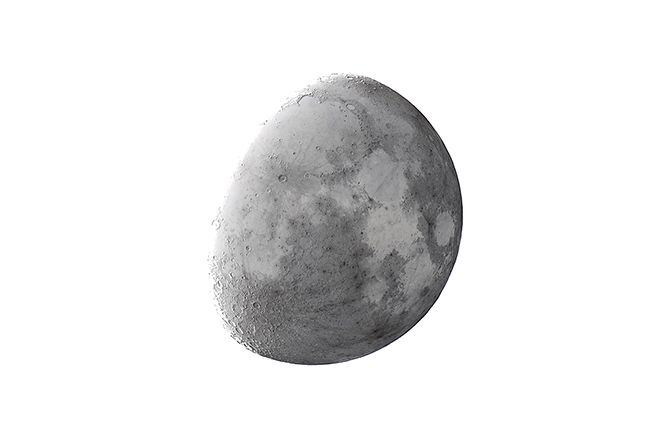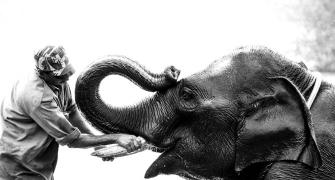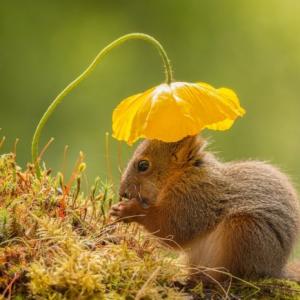 From captivating photos of Northern Lights, sparkling galaxies, the ‘man on the moon’ and more, photos taken by the winners of the Insight Astronomy Photographer of the Year 2016 competition are an absolute treat.
From captivating photos of Northern Lights, sparkling galaxies, the ‘man on the moon’ and more, photos taken by the winners of the Insight Astronomy Photographer of the Year 2016 competition are an absolute treat.
Run by the Royal Observatory Greenwich, the competition -- now in its eighth year -- received an unprecedented 4,500 entries from over 80 countries.
The winning images are on display in a free exhibition at the Royal Observatory Greenwich in London from September 17 until June 28, 2017.
Here’s a special collection of some of the award winning photos.
(Please click on the photos to view hi-resolution images)
>> Overall winner
Baily’s Beads, Yu Jun
The Baily’s beads effect is a feature of total solar eclipses. As the Moon passes the Sun during a solar eclipse, the rugged lunar limb allows beads of sunlight to shine through in some places, and not in others. I took a series of photos of the total solar eclipse of 2016, in Luwuk Indonesia, and stacked them with software to show the Baily’s beads. Photograph: Yu Jun/Astronomy Photographer of the Year 2016
>> Aurorae, winner
Twilight Aurora, György Soponyai
On the evening of the total solar eclipse in 20 March 2015, the people of Spitsbergen were treated to a second natural lightshow in the form of the Aurora Borealis. At the time the photograph was taken the Sun was shining 9 degrees below the horizon, meaning it was evening nautical twilight on the shore of Greenland Sea. The Adventtoppen Mountain, standing at 2,579 ft tall, towers over the orange-hued expanse in the foreground, as the Northern Lights gambol across the night sky. Photograph: György Soponyai/Astronomy Photographer of the Year 2016
>> Aurorae, runner-up
Black and White Aurora, Kolbein Svensson
An unusual view of the aurora, simply in black and white, that turns the expectations of aurora photography on its head. The removal of the vivid colours so commonly associated with the Northern Lights emphasises the fluidity of the aurora and the stark contrast it forms against the night sky. Photograph: Kolbein Svensson/Astronomy Photographer of the Year 2016
>> Best newcomer
Large Magellanic Cloud, Carlos Fairbairn
The Milky Way’s satellite galaxy and close neighbour, the Large Magellanic Cloud, showcasing stars of all ages lying within its 14,000 lightyear diametre. The Large Magellanic Cloud can sometimes even be seen with the naked eye from the southern hemisphere, but resembles a faint cloud rather than a huge galaxy. Photograph: Carlos Fairbairn/Astronomy Photographer of the Year 2016
>> Galaxies, winner
M94: Deep Space Halo, Nicolas Outters
Discovered in 1781, Messier 94, or M94, is a distant spiral galaxy lying approximately 16 million lightyears away from our planet, that is notable for its two-ringed structure. At the centre of the structure the shimmering pinks of the inner ring show the hectic star forming activity leading to its sometimes being referred to as a starburst ring. The photographer has also captured the often unseen galactic halo of M94 made up of stars, hot gases and dark matter. Photograph: Nicolas Outters/Astronomy Photographer of the Year 2016
>> Galaxies, runner-up
Towards the Small Magellanic Cloud, Ignacio Diaz Bobillo
One of the Milky Way’s closet neighbours, the Small Magellanic Cloud, is seen on the left hand side of the image in a flurry of blues and pinks that illustrate the several hundred million stars contained within the dwarf galaxy. The globular cluster, 47 Tucanae, is seen glowing a vibrant orange, in the upper right corner of the photograph. Photograph: Ignacio Diaz Bobillo/Astronomy Photographer of the Year 2016
>> Our Moon, winner
From Maurolycus to Moretus, Jordi Delpeix Borrell
An incredibly close-up view of the roughhewn lunar landscape littered with craters and craterlets largely forged by impacts from meteors and asteroids. Photograph: Jordi Delpeix Borrell/Astronomy Photographer of the Year 2016
>> Our Moon, highly commended
Moonrise at the Pier, Sergio Garcia
The Full Moon glows a soothing yellow as it rises over the Galveston Island Historic Pleasure Pier in Texas, USA, almost appearing to hitch a ride on the ferris wheel. Photograph: Sergio Garcia/Astronomy Photographer of the Year 2016
>> Our Sun, runner up
Sun Flower Corona, Catalin Beldea and Alson Wong
A composite of 12 images taken during the total solar eclipse on 9 March 2016 from TidoreIsland in Eastern Indonesia. Resembling tentacles, the blistering solar coronal structures reach out from the Sun’s surface with an average temperature of between one and three million kelvin. In this striking image, the features on the Moon’s face are also visible, but not because of the light from the Sun. The Moon is in fact illuminated by the sunlight reflected from our very own planet in a phenomenon known as Earthshine. The pink glow at the top left of the Moon comes from a solar prominence. Photograph: Catalin Beldea and Alson Wong/Astronomy Photographer of the Year 2016
>> People & Space, winner
City Lights, Wing Ka Ho
Star trails depicting the movement of the Earth, gently arc over the towering buildings peppered with neon signs and light pipes in the bustling Quarry Bay of Hong Kong. The light pollution in Hong Kong means that only a few stars are generally visible in the night sky, but this photograph shows that despite this you can still engage in some stargazing wherever you are in the world. Photograph: Wing Ka Ho/Astronomy Photographer of the Year 2016
>> People & Space, runner up
Man on the Moon, Dani Caxete
A stargazer perches on the mountain known as Peña Muñana in Madrid, Spain basking in the warm glow of the rising full Moon. Photograph: Dani Caxete/Astronomy Photographer of the Year 2016
>> People & Space, highly commended
A Wise Son Makes a Glad Father, Robin Stuart
The touching scene of a Maasai warrior bestowing his knowledge of the stars on his son as they gaze up at the Milky Way. The Maasai tribe use the stars to navigate across the east African plains in order to find new grazing grounds for their livestock. Photograph: Robin Stuart/Astronomy Photographer of the Year 2016
>> Planets, Comets & Asteroids, winner
Serene Saturn, Damian Peach
The second largest planet in our solar system, the gas giant Saturn, imaged on March 18, 2016. The photograph clearly depicts the planet’s famed rings in great detail with striking contrast between each of them. Storms are visible across the face of the planet, as well as the astronomical mystery that is the hexagon at Saturn’s north pole. Photograph: Damian Peach/Astronomy Photographer of the Year 2016
>> Skyscapes, winner
Binary Haze, Ainsley Bennett
A misty morning in October on the Isle of Wight is the setting for this image resembling an eerie scene from a science fiction film. The obscuring weather actually accentuated the brightness of Venus and the crescent Moon and transformed them to appear as glowing orbs floating over the Ashey countryside. Photograph: Ainsley Bennett/Astronomy Photographer of the Year 2016
>> Skyscapes, highly commended
Geminids over the LAMOST Telescope, Yu Jun
Meteors blaze across the night sky as the Geminids reached their peak on 14th December 2015 in the Hebei Province, China. Over 100 meteors are featured soaring over the Guoshoujing LAMOST telescope of the National Astronomical Observatories of China in this composite image. Photograph: Yu Jun/Astronomy Photographer of the Year 2016
>> Young astronomy photographer, winner
Lunar Reversal, Brendan Devine
A truly innovative image of the Moon that has been inverted to bring out the intricate details of the rugged, lunar landscape that we often miss in more traditional shots of our natural satellite. Photograph: Brendan Devine/Astronomy Photographer of the Year 2016
>> Young astronomy photographer, runner up
What the City Does Not Show You, Jasmin Villalobos
A man stands on a hill on Canyon Lake, Arizona, silhouetted against a night sky that fades from the moody, blue light pollution seen on the right hand side to the darkness that hangs over the desert. Photograph: Jasmin Villalobos/Astronomy Photographer of the Year 2016


























